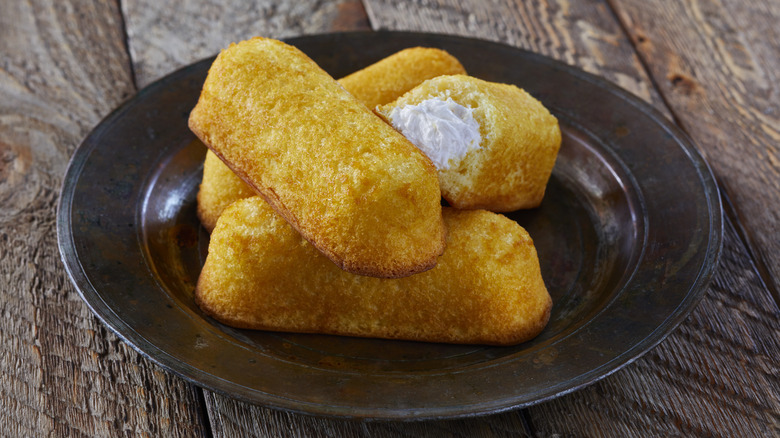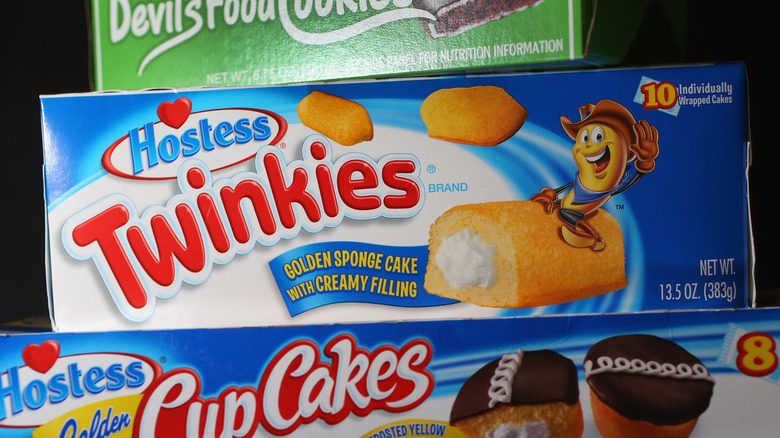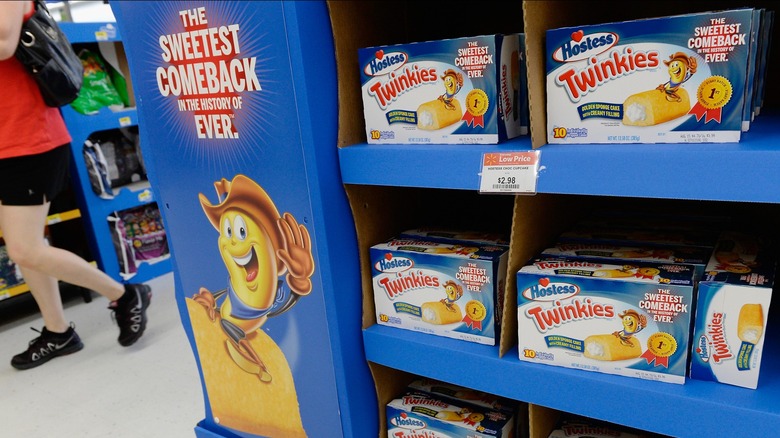Remember When Twinkies Were Almost Discontinued Forever? Here's Why
Twinkies are the epitome of food nostalgia. Children (and many adults) have enjoyed the spongy, golden, cream-infused cakes for generations in the United States and beyond. The Continental Baking Company conceptualized the treat in 1930, in the throes of the Great Depression. Since resources were limited, and making the most of them was the name of the game, the company created Twinkies to capitalize on excess cake batter. The same went for other modern classics like red velvet flavor — the Depression bred many cheap and innovative treats. Soon after, the Continental Baking Company turned into Hostess, and Twinkies promptly went from a concoction of excess cake to a national treasure, right up there with Ding Dongs, CupCakes, and many more of Hostess' confections.
Though they quickly grew into a household name after their inception, Twinkies almost reached the end of their long road in the 2000s. A combination of health concerns among consumers and economic struggles among the producers led to the ultimate bankruptcy of Hostess. However, an unwavering fandom ultimately fought to keep Twinkies, along with Hostess' other sweet snacks, in swing.
The (nearly) fatal flaws in Twinkies
Twinkies are undeniably delicious, and while Hostess marketing was probably content not to highlight its ultra-processed, preservative-rich qualities, once popular culture dubbed it an apocalypse-proof snack, it kind of had to own the reputation. With ingredients carrying names like "sodium stearoyl lactylate" and "pyrophosphate," and a high sugar content (32 grams per serving), Twinkies started alarming an increasingly health-conscious consumer population in the 1990s and 2000s. As BI put it, "Loaded with calories, sugar, and preservatives most people hadn't heard of, let alone could pronounce, Twinkies became a casualty of the health revolution." In fact, Twinkies are one of the American foods banned in other countries today due to its ingredient content.
Thanks to growing consumer awareness and the inability of then parent company Interstate Bakeries to efficiently produce and distribute their goods, profits plummeted at the turn of the century. Come 2004, the company found itself with $700 billion worth of debt and filed for bankruptcy. Though it came back in 2009 under the Hostess Brands rebrand in 2009, it found itself back in bankruptcy in 2012. The world may not have ended during this — according to Mayan prediction — apocalypse year, but Twinkies almost did.
How nostalgia fueled hopes for Twinkies' return
However, when the threat of Twinkies' demise loomed, the public raided store shelves for the last of the product, and boxes started selling on the internet for up to $1000. "It was like the death of a piece of Americana," Andy Jhawar, partner at Apollo Global Management told BI. And it's hard to disagree; besides being an early packaged snack in the U.S., Twinkies were immortalized in the Die Hard franchise, Ghostbusters, and beyond. Jhawar recognized the sheer power of nostalgia in this moment — even if the product was not performing well before, it certainly was now.In 2013, his company, in partnership with Metropoulos & Company, invested almost $200 million to buy some Hostess I.P., including Twinkies.
Fast-forward a few years, and it's safe to say that Twinkies are not only back, but arguably better than ever. Come 2016, the Twinkies brand was once again sold, this time at a $2.3 billion valuation. In addition to the classic cakes, Hostess is now selling mini versions of its most iconic snacks, including Twinkies mini cakes. Twinkies come in many sweet flavors, and a gluten-free variety may be in the works, too. Though the future of Twinkies cannot be known for sure, the American sweet has certainly proven that sentimentality can be quite lucrative.


